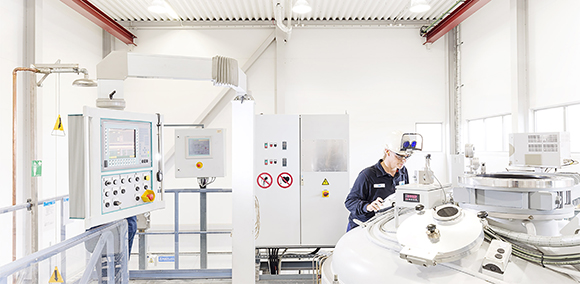Sandvik achieves AS9100D aerospace certification for Ti and Ni-based superalloy powders
April 30, 2020

Sandvik Additive Manufacturing, a division of Sandvik AB, headquartered in Stockholm, Sweden, reports that its new powder plant for titanium and nickel-based superalloys has received AS9100 Revision D certification for deliveries to the aerospace industry. The company believes that this will accelerate the adoption of additively manufactured titanium parts, as well as a shift towards sustainable manufacturing.
The powder plant for Osprey® titanium and nickel-based superalloys was officially opened at the end of 2019 in Sandviken, Sweden. Since then, Sandvik explains that extensive work has been ongoing to ramp-up the highly automated plant, fine-tuning all processes and qualifying the powder to ensure the best possible consistency, morphology and quality suitable for Additive Manufacturing. The first two titanium powders produced at the plant are Osprey Ti-6Al-4V Grade 5 and Osprey Ti-6Al-4V Grade 23. The nickel-based superalloys are Osprey Alloy 625 and Osprey Alloy 718.
“Having atomised fine metal powders for more than forty years, and supplying titanium to the the aerospace industry since the 1980s, Sandvik is no stranger to powder atomisation or the requirements of the most demanding industries,” stated Keith Murray, Vice President of Global Sales, Sandvik Additive Manufacturing.
“Now we are one of few companies that has the new and prestigious AS 9100D quality certification for our Osprey titanium powder and nickel-based superalloys used for Additive Manufacturing. It is a true milestone, which will facilitate many customer collaborations going forward. Imagine what 158 years of leading materials expertise can do for your additive process.”
A shift towards sustainable manufacturing
According to Sandvik, its titanium powders for Additive Manufacturing support the shift towards sustainable manufacturing, as the AM process results in far less material waste than traditional subtractive techniques, while also encouraging new levels of design freedom. The company states that this is opening up the use of titanium in other industries such as automotive and tooling and that Sandvik’s own Lightweight CoroMill® 390 is excellent proof of this as the additively manufactured version of the mill is said to be more than 80% lighter and up to 200% more productive.
Sandvik further states that Powder Metallurgy is also labelled as a ‘recognised green technology’ – and the net-shape capability of technologies like Additive Manufacturing not only means that material waste is minimised, but also that great energy efficiency can be achieved, by eliminating manufacturing steps.
Murray added, “If combining this with a light and strong material like titanium, the sustainability advantages can be enormous. Weight reduction is, for example, a constant key issue for the aerospace industry, driven both by fuel cost and carbon footprint. The same is true for cars and trucks, and everything else that moves. Each kilogram of weight loss on an airplane saves about $3,000 per year in fuel – and can make a great difference for the planet.”

Traceability and consistency
In addition to a shift towards sustainable manufacturing, Sandvik explains that traceability is of vital importance in the aerospace industry, the company can offer an incomparable level of traceability for its titanium powder, which is made possible by having the full supply chain inhouse – from titanium sponge to finished powder.
The new titanium powder process uses advanced electrode inert gas atomisation technology to produce highly consistent and repeatable titanium powder with low oxygen and nitrogen levels. The automated production process is also supported by several industrial robots and a dedicated downstream sieving, blending and packing facility. The new powder plant is located next to Sandvik’s Additive Manufacturing facility, which includes all relevant AM processes for metals. This company says that this means it can tailor the powder to different AM processes, on the same site.
Murray concluded, “In Additive Manufacturing it is essential to use high-quality metal powders with consistent quality, adapted to the different Additive Manufacturing processes. Our highly automated manufacturing process ensures excellent consistency – and the powders demonstrate optimal particle size distribution.”
Kristian Egeberg, President of Sandvik Additive Manufacturing, commented, “Sandvik is a world leader in metal powder for Additive Manufacturing with the widest alloy program on the market. Titanium powders represent the latest application of 158 years of materials knowledge and R&D – and more than forty years in-house powder manufacturing capabilities. With the AS9100D certification together with all our experts in materials, metal powder and Additive Manufacturing, we can now help our customers succeed even faster in this high-growth area.”
















